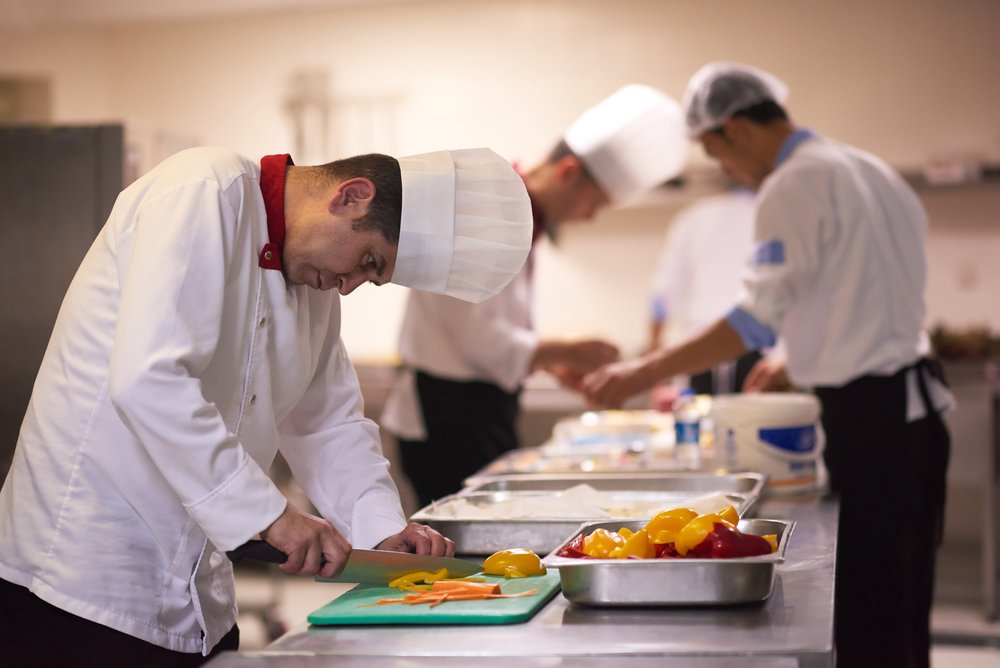The lean restaurant idea is really referring to the “lean manufacturing” concept. Lean manufacturing is a production approach where expending resources for any goal other than the creation of value for the end customer is considered wasteful.
A lean restaurant operation will place greater focus on the operations to produce meals. Specifically, they investigate how to reduce the production of waste, cut down on time spent by employees and equipment, and how to reduce the overall cost of the product. The core tenets of a lean restaurant are:
1. Value
2. The Value Stream
3. Flow
4. Pull
5. Continuous Improvement
Value
Value is the amount that someone is willing to pay for something. For example, if your restaurant produces chicken tenders, there is a certain amount of money customers are willing to pay for that product. Changing quality, speed, or service may affect the customer’s willingness to pay different amounts. A customer might pay more for hand breaded chicken, and less for previously frozen, par-cooked chicken tenders. The lean restaurant focuses on delivering products such that they can turn a profit while delivering value to their customers.
The Value Stream
Once value has been defined, the value stream defines the steps to create the value. In the case of the chicken tenders, this begins with buying the raw chicken, the breading, and the batter. Next is receiving the materials and storing them. At this point there are steps internal to the kitchen which might include thawing, breading, frying, packaging, holding, and even point of sale operations. The lean restaurant maps every step, looking for ways to remove unneeded expenses and wastes in time and product.
Flow
Traditional forms of high-volume production often include batch-and-queue. This idea makes perfectly good logical sense. Once the chicken breading station is set up, run as much product through as you can to eliminate time spent on multiple setups and cleanups. There are hidden problems in this method.
In the extreme case of the chicken tender example, one might bread all the chicken for the day at the same time, then fry it all at one time, then hold it until the customer orders it. If breading enough chicken for the whole day, it is likely that the raw chicken could spoil before it makes it to the fryer. If we fry all the chicken at one time, most pieces will sit for too long resulting in soggy, lower quality products. Even worse, you risk cooking more chicken than there is demand for and throw out product at the end of the day.
The lean restaurant focusses on reducing inventory and waiting time. Inventory can be any materials (breading and chicken) or work in progress (uncooked breaded chicken) that have not yet been handed over to the customer in exchange for money. The goal is to make each step in the process take the same time. If breading chicken takes longer than frying, there is a chance the breaded chicken will pile up in front of the fryer, possibly even spoiling before it gets cooked. In the perfect system, one fryer basket of chicken gets breaded at a time, then goes directly into the fryer. For this to work, the frying operation must take the same amount of time as breading. This way the fryer is always just ready to go when chicken has finished breading. Inventory will pileup in front of any operations, upstream or downstream, which are slower. Some operations may be broken up, some may be added together to get uniform timing for each step.
In the end, the objective is to deliver exactly what the customer requested, at the time they expect it. Nothing more, nothing less. By reducing large batch sizes, you also eliminate the need to wait for a massive batch of chicken to go through each step, just to deliver a single meal. In a lean restaurant, holding cabinets can be reduced or eliminated all together if food items are produced in perfect harmony. Do not forget that in the complete meal, we make sure that the sides and beverages are turned out at the same time too!
Pull
The traditional restaurant runs on “Push” methodologies. They use data from the previous weeks, months, and years, and produce the amount of product they believe is needed. The trouble is that these predictions can be wrong. The result would be producing food and throwing it out, or not having enough food to keep up with the day’s demand. Either way this results in additional cost to the business.
The lean restaurant relies on the “pull” of the customer. Ideally the system does not produce products until the customer requests them. Restaurants are becoming much more effective at delivering meals right on time without having to hold items. If the Value Stream has been properly optimized, it is possible to deliver products to the customer with minimal or no batching. Restaurant IoT can start the preparation process at the moment data is entered into the cash register. This will help lean restaurants deliver fresh meals quickly and reduce wasted food and man-hours.
Continuous Improvement
Implementing lean restaurant practices can be overwhelming. The idea behind continuous improvement is that a restaurant does not need to completely revamp its processes overnight. It begins by improving one operation at a time. As long as products cannot be produced instantaneously, there will always be opportunities to cut down on time and waste. The lean restaurant is always looking for ways to improve the system.
If you liked what you read, please share! You can do this easily by clicking the round buttons with the logo of your preferred social media platform at the top of this post.

